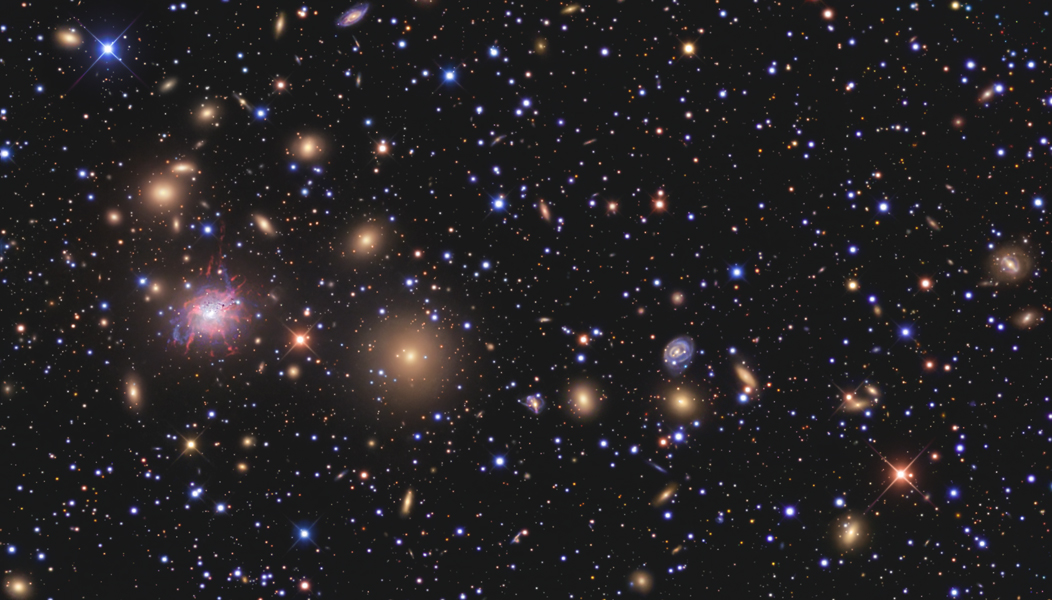Dark Matter and Dark Energy
Scientists have known, for decades, that there was insufficient material to explain the motion of the galaxies within the Universe. Like generations of sunburn victims that preceded the identification of ultra violet radiation, scientists, for quite some time, have believed that ninety percent of the Universe must be filled with some form of
(dark) matter which simply could not be seen. But, the recent evidence for accelerated universal expansion has required astrophysicists to re-examine their theories about the contents of the Cosmos. The solution that has gained greatest credence also relies on the existence of something else we cannot yet sense- an anti-gravitational force known as
dark energy.
Today, many scientists believe that seventy percent of the Universe is comprised of this dark energy with dark matter occupying twenty five percent. That means everything we see in the heavens- over 400 billion galaxies each ablaze with hundreds of billions of stars, the stars of our own galaxy, our Sun, our Moon, our neighboring planets and the Earth itself- accounts for only a small fraction of everything that exists- a measly five percent. Or, to put it another way: about ninety-five percent of the Universe is invisble to us!
We have come very far from being the center of all things!
The organization of the Universe follows a hierarchical pattern. For example, stars, interstellar gas and cosmic dust are organized into systems called galaxies. There are an estimated 400 billion galaxies strewn throughout the Universe, each is home to hundreds of billions of stars. Galaxies seldom exist in solitude and are usually part of a gravitationally bound group with up to fifty other constituents. Interestingly, our Milky Way belongs to a collection of about forty relatively nearby star systems that is affectionately known as the Local Group. Groups can collect into clusters forming a host of several thousand galaxies. Groups, clusters and some isolated galaxies can form even larger associations called super clusters. At the very largest scale of the visible universe, matter is gathered into filaments and walls that surround vast
voids. These structures resemble soap bubbles. Galaxy groups and clusters tend to congregate where the bubbles meet.

- The Perseus Galaxy Cluster lies about 250 million light years from Earth and contains one of the brightest x-ray sources at its heart- NGC 1275.
Click here for a larger version of this image.
- Photo credit: R. Jay GaBany, Cosmotography.com
The gravity exerted by the luminous parts of a galaxy cluster is insufficient to hold the cluster together. Thus, scientists have concluded the missing adhesive must be dark matter and since it's invisible to modern instruments- it can only be inferred. So, when you view the accompanying image of the
Perseus Galaxy Cluster, you can't believe your eyes because you're only seeing a small fraction of what's actually there.
The Perseus Galaxy Cluster
This cluster contains about five hundred galaxies located approximately 250 million light years away towards the northern constellation of Perseus. The picture (right) captures an area about 1.5 million light years wide. It also contains hundreds of stars shining in our home galaxy.
NGC 1275

- The super-massive black hole at the center of NGC 1275 spews bright jets and filaments into the material surrounding the galaxy cluster. A less distant spiral galaxy, superimposed by our line of sight, is on a collision course wth the large elliptical galaxy.
- Photo credit: R. Jay GaBany, Cosmotography.com
In one
section of the picture (left), an enormous pair of galaxies can be seen racing toward each other at over six million miles per hour (9.7 million kph). In the foreground, a spiral galaxy is in the process of merging with the more distant elliptical star system- although many astronomers suspect the merger has not yet commenced. The spiral is slightly tilted so that its spiral arms are at an angle to our line of sight. You can also see some of its dust lanes as dark threads superimposed and partially obscured in the glare of the galaxy behind it.
The large elliptical galaxy, further in the distance, is called NGC 1275 but this star system is also known as Perseus A because it's one of the brightest sources of x-rays in the sky. Most astronomers suspect the x-rays emanate from a super massive black hole at the elliptical galaxy's center. Enormous jets and filaments, some stretching twenty thousand light years, extend from the black hole into the galaxy cluster- each thread contains a million times the mass of our Sun. The elliptical lies at the heart of the Perseus Cluster and it provides a unique opportunity to see the effects of an active black hole on it environs.

- Supernova 2008fg outshines all the stars in its host galaxy, NGC 1268, in this chance exposure.
- Photo credit: R. Jay GaBany, Cosmotography.com
Serendipity often plays a factor when taking deep space images and this picture is no exception- each exposure captured the brief appearance of a mighty supernova, designated SN2008fg, in one of the distant blue spirals caught in the cluster's field of view. It was discovered on August 30, 2008 by the 30-inch
KAIT robotic supernova patrol telescope located at the historic Lick Observatory above San Jose, California, where the author lives. The stellar explosion, characterized by its bright blue color, is located near the bottom right edge of the galaxy (right). This cataclysmic event easily outshines the combined light of its home star system, NGC 1268.
* * * *
